(Click on an image for the full version!)
Up the Tambopata
from Puerto Maldonado
|
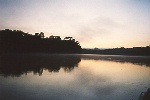
Sunrise over the Tambopata river.
|
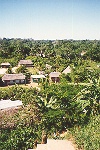
View from the dock in Puerto Maldonado.
|
The flight from Cuzco to Puerto Maldonado was yet another
spectacular one: a veritable ocean of clouds rolled out beneath us,
broken only by an occasional Andean standout ("I'm a mountain, I'm a
mountain!"). Suddenly, it seemed, we plunged headlong into this sea,
only to find another one below, this time a mass of green that, it
dawned on us, was the jungle. *
|
| Puerto Maldonado is the capital of the Madre de Dios jungle
region. Much to Tien's displeasure, the technical name for this kind
of jungle is ``sub-tropical moist forest'' (because it's below the
tropics and has a dry season) -- as many know, m. is her least
favorite word! Fortunately, our excellent guide Max humored her by
substituting "m" for the offending word every time. This was only the
first of many signs that Max was no ordinary guide. Sure, he took us
on muddy hikes through the jungle and showed us a dead beetle and a
live bat -- that's par for the course. But it's not just any
guide who makes sound effects!
|
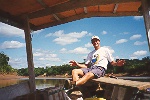
Our guide Max on the boat en route to the Explorer's Inn, after
shocking us by pulling his camera out to take pictures of
us.
|
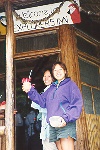
Welcome to the jungle!
|
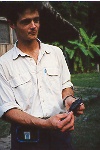
Max shows us a dead rhinoceros beetle that was found
crawling around the Inn.
|
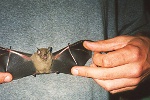
Max set up his net near the main lodge, and by the end of the evening
he was able to cap off his bat lecture with this live specimen!
(Their reputation is undeserved, he tells us, since they are mostly
quite harmless.) It was a new species for this area too!
|
After our three-hour journey up the Tambopata River, we were greeted
at the Explorer's Inn with cool tropical fruity drinks. Our time at
the inn was relaxing: an afternoon walk to see the jungle sunset;
lectures on bats, frogs and caimen; napping and reading in the sun; a
morning hike to the lake, where we were lucky enough to catch sight of
giant otters from afar. Our luck seemed to hold: it wasn't too hot for
comfort, humidity was definitely tolerable and there weren't many
mosquitos at all! (This is particularly fortunate since the two of us
who had read a rather alarming article about psychotic side-effects of
taking Larium had foregone malarial prevention on the advice of the
SAEC, given the lack of cases reported in the particular area we were
going to and the brevity of our stay.)
|
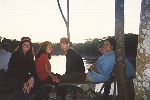
Sunset over a piranha-infested river.
There are also caiman (a kind of crocodile) here, although they
usually come out only at night.
|
We also saw monkeys jumping between trees high up in the canopy,
caiman shyly poking their noses above the water during a nighttime
outing on the river, swarms of butterflies fluttering by and
leaf-cutter ants carrying leaves many times their size (and sometimes
bearing other smaller freeloading ants!). Unfortunately, all these
proved difficult to capture on film. And the birds -- pairs and
flocks of macaws in flight were probably the most colorful, but the
award for most memorable bird has got to be the screaming piha, which
made the most amazing laughing sounds that were, naturally, quite
contagious. That familiar jungle hum that we'd first encountered on
the Inca Trail was even more intense here, providing constant
testimony to the diversity of life that surrounded us.
|
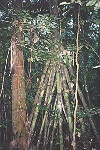
An open-stilted palm. This is an adaptation to extract water
from a large area and to provide support against flooding.
|
Fortunately, diverse forms of vegetation posed more cooperatively for
us. (Of course, the open-stilted palm is also known as the walking
palm, since over time it can actually move!) Max showed us all sorts of
adaptations that convinced us how smart these trees are -- it's
amazing what these things do for light!
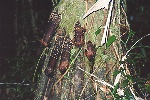
A closed-stilted palm
with a peculiar phallic
growth. Max
didn't
have to tell us what
its nickname was!
|
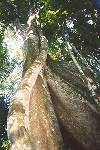
One tree grew around the other, stole all its nutrients and then
used its dead body for support. Corporate takeovers are nothing
compared to this!
|
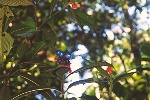
Unmistakably blue, and all natural!
|
Drum roll, please: After years of wondering whether there
are any naturally blue foods (where the general consensus is that
blueberries aren't really), we can confirm the existence of at least
one genuine article: the "hot lips" plant has a true-blue berry with
(they say) potent effects.
|
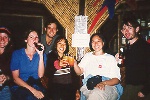
Tequila sunsets (Tien's concoction) on our last night.
|
At this point our paths diverged (briefly). Tien and Rachel stayed on
for another day of spying on monkeys and looking for bats at a
different lodge, while Kevin and Nancy headed back to Cuzco for one
more meal at Al Grano and a long train ride...
Page created by Kevin Murphy and Nancy Chang (with
travel partners Rachel Chalmers and Tien-Shun Lee in spirit!).
All images © 1998. All rights reserved. Please ask permission before
copying.
Last update July 6, 1998.
Comments welcome!


